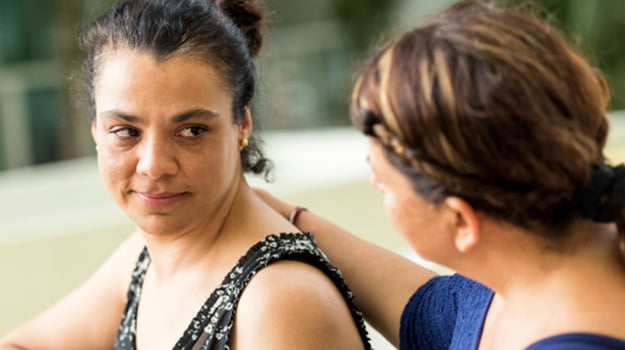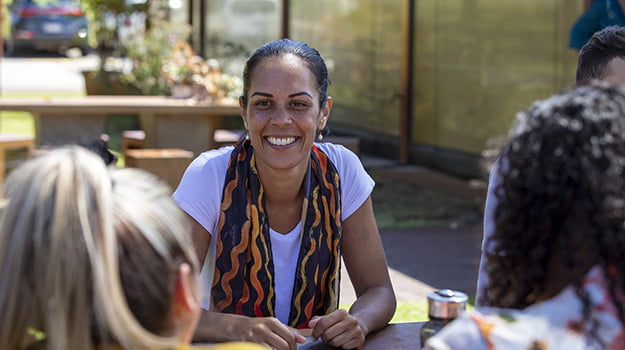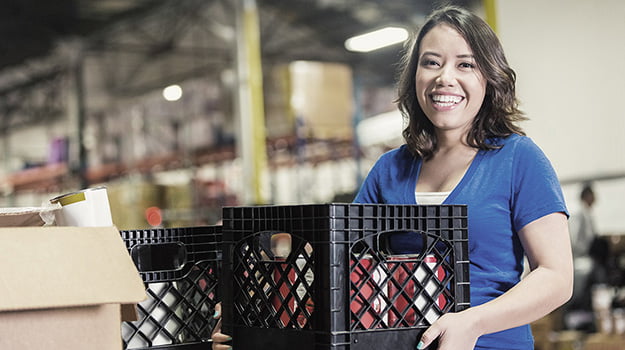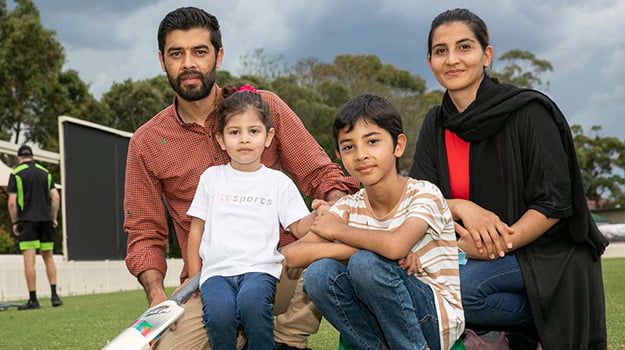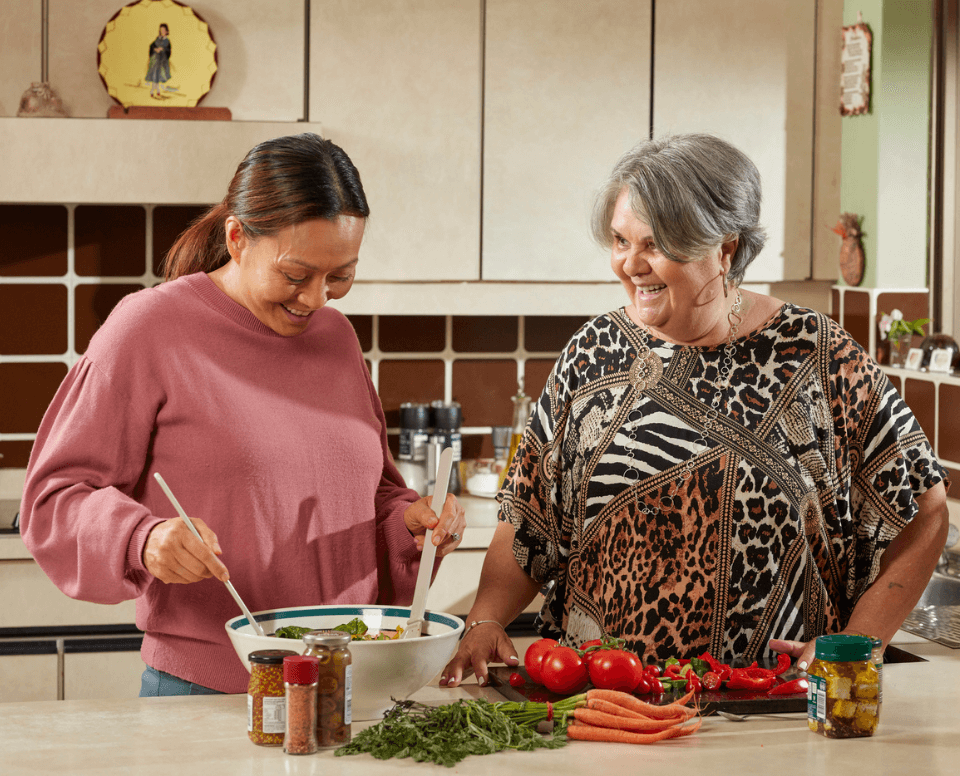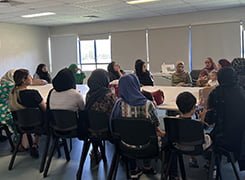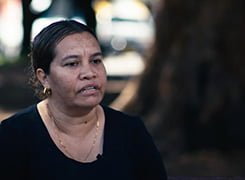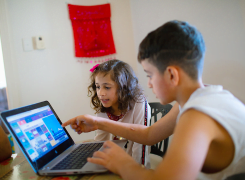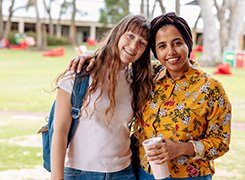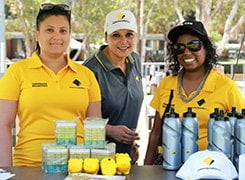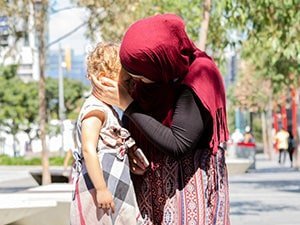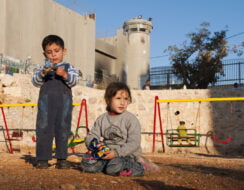07 Sep 2015
NewsSSI food: Sameera’s family favourites
Sameera Purkis
I migrated to Australia from Pakistan in 2011. After I completed my Masters in International Relations, I worked as a high school teacher in Pakistan and taught history and geography. Before that I worked as an investment banker and as a journalist.
For SSI’s Community Kitchen I cooked Pakistani cuisine: qeema aloo, masoor ki tadka daal and mixed vegetable pakoras. I chose this particular menu as it makes me nostalgic for home and my family.
Back in Pakistan, usually qeema aloo and masoor ki tadka daal with freshly cooked chapatis and boiled white rice would be our Sunday lunch, which we used to get quite excited about. I remember these two were the first meals I ever cooked and everyone in my family loved it.
After I came to Australia, I noticed that not a lot of people know about ordinary, everyday Pakistani food.
These are very simple, easy-to-cook and time-efficient recipes, dishes that my mother is an expert at cooking. They were my favourite dishes growing up and still are. I remember how I would come home from school or college and I would ask my mum what’s for lunch — and how excited I would get if she’d tell me she’d cooked qeema aloo or daal chawal (boiled white rice).
Pakoras, mostly eaten as a snack, is something very significant in Pakistani culture. It’s made of gram flour which is called “besan” in Pakistan and India.
We lived in a region that doesn’t get a lot of rain. So whenever it rained, which was usually monsoon season, everyone would celebrate and you could smell people cooking pakoras everywhere.
Karachi, where I come from, was a very chaotic place riddled with a lot of political instability and violence. But, whenever it rained, everyone seemed to forget about how scared and stressed they were and just eat and share pakoras and jalebis, which is a sweet snack.
I have always loved to cook. In my little world, I was a wannabe chef and had a strong understanding of spices and how they worked. I especially love sub-continental food, perhaps because I grew up with it and it comes very easy to me to cook.
When I first came to Australia, I had to cook as my mum wasn’t here to cook for me. I remember I went to a sub-continental grocery store and I just knew what to buy as I remembered what my mother used to put in her curries. I came home and cooked a curry and it turned out to be really good.
I believe when you grow up watching your mum cook every day, you sort of instinctively know how to cook and that’s what happened to me. However, I still need my mother’s guidance here and there while cooking.
Qeema Aloo

Serves: 6 people
Ingredients
1 kilo beef mince
2 x onions (finely chopped)
3 x tomatoes (thinly sliced)
3 x potatoes (cut in cubes)
3 x bay leaf
1.5 tsp cumin seeds
2 tbsp garlic and ginger paste
1 tsp (or to taste) ground red chilli
1.5 tsp ground coriander
½ tsp ground turmeric
2 to 3 dried fenugreek leaves (kasoori methi)
1 tbsp fresh ginger julienned (cut thin, keep some for garnish)
1 to 2 tsp garam masala
1 to 2 (or to taste) large green chillies (for garnish)
½ bunch fresh coriander (for garnish)
½ cup olive oil
Preparation time: 20 minutes
Cooking time: 40 minutes
Method
Heat the oil in a pot on medium high. Once heated, add bay leaves and cumin seeds and sauté for a few seconds until fragrant. Add onion and fry until it changes colour to slightly golden. Add ginger and garlic paste and fry until fragrant. This will take about a minute.
Add the mince and cook until brown. Stir and break up the mince with a wooden spoon. Once the colour changes to brown, add red chilli powder, coriander powder and turmeric powder and cook for a couple more minutes. Add tomatoes and salt. Mix the mince with tomatoes and cover the pot, bringing the heat down to medium low. Keep checking to see whether the tomatoes have cooked.
Once the tomatoes are cooked, add potatoes and let them cook on medium heat. Once the potatoes are cooked, add about half a tbsp of julienned ginger, fenugreek leaves and garam masala and cook for a further 3 to 5 minutes.
Garnish with chopped coriander, julienned ginger and green chillies. Serve with boiled white rice or naan bread.
Masoor Ki Tadka Daal
1 cup red lentils (masoor)
3 cups water to boil
1tsp red chilli powder
½ tsp turmeric powder
¼ tsp asafoetida (herb extract used in Pakistan and India) powder
2 tsp garlic paste
Salt to taste
Tadka (fried spice garnish)
4 to 5 garlic cloves finely sliced or chopped
8 to 10 curry leaves
2 to 3 dried whole red chillies
1 tbsp cumin seeds
About 2tbsp oil or ghee to fry
Method
Wash the daal and drain. Put the daal in a pot and add 3 cups of water along with the red chilli, turmeric, garlic paste, salt and asafoetida powder. Cook on medium heat until daal is cooked. You should be able to tell it’s cooked when the water is completely mixed and it looks like a mush.
When the daal is cooked, heat some ghee, or butter or oil, and add cumin seeds, chopped garlic, curry leaves and whole red chillies and fry until fragrant. When the garlic changes colour to golden, add the garnish in the cooked daal and immediately cover the pot and leave it for about 5 minutes. Serve with boiled white rice or naan bread, with a salad of onion, tomatoes, cucumbers and green chilli on the side.
Vegetable Pakoras
3 cups gram flour (besan)
2 x medium onion (finely chopped)
1 bunch fresh English spinach
1 potato (cut into very small cubes)
2 to 3 large green chillies (finely chopped, seeds removed)
1 bunch coriander (finely chopped)
1 tbsp carom seeds (ajwain)
Salt to taste
½ tsp (or to taste) crushed red chilli or chilli powder
2 tsp garlic paste
2 tsp cumin seeds (crushed in mortar and pestle)
Vegetable oil for deep frying
Method
Put the gram flour (besan) in a wide bowl, add salt, red chilli, carom seeds (ajwain), garlic paste, crushed cumin seeds and salt. Mix together. Add about ½ to one cup of water, carefully determining the consistency. The consistency should be not too runny and not too thick. When it’s scooped up in a tbsp, it should slowly drop down and not trickle.
Add all the vegetables and mix it well. Put it aside for about 10 minutes.
Heat oil in a shallow wok or a frying pan on medium high. Test the heat by dropping half a tsp of the pakora batter. The oil is ready if the batter rises up almost instantly. Start frying pakoras by scooping the batter in a tbsp and dropping it in the hot oil. Let it slightly cook on one side and then keep turning until the colour is a dark golden. If they start getting too dark too soon, bring the heat down to medium.
Put them on paper towel to drain the oil. Serve warm with raita and chutney.



